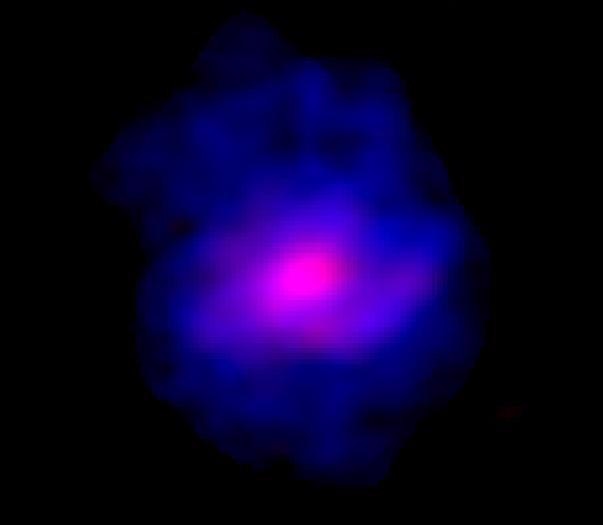Feb 12 2021
Researchers have challenged the existing knowledge about the formation of galaxies by unraveling images of a young galaxy in the early life of the Universe, which looks astonishingly mature.
 A picture of ALESS 073.1 just 1.2 billion years after the Big Bang. Image Credit: Cardiff University.
A picture of ALESS 073.1 just 1.2 billion years after the Big Bang. Image Credit: Cardiff University.
Named ALESS 073.1, the galaxy seems to exhibit all of the features predicted for a very mature galaxy and has led the team of researchers to question how it expanded so fast. The new study was published recently in the journal Science.
Galaxies occur in a range of sizes, shapes, and colors, and are formed of various components like “bulges,” spiral arms, and rotating disks.”
The main aim of modern astronomy is to gain insights into why different galaxies appear the way they are at present and when their various components formed.
Led by researchers at Cardiff University, the team employed the Atacama Large Millimeter/submillimeter Array (ALMA) telescope as a “time machine” to look through the remote past, unraveling how ALESS 073.1 appeared just 1.2 billion years after the Big Bang.
Since the light emitted from the galaxy required billions of years to hit the telescopes on Earth, the researchers could explore how the galaxy appeared during its infancy and find how it was formed st first.
The outcome was one of the sharpest and direct pictures of a primordial galaxy ever generated, which enabled the researchers to perform an in-depth study of its internal structure.
We discovered that a massive bulge, a regular rotating disk, and possibly spiral arms were already in place in this galaxy when the Universe was just 10% of its current age. In other words, this galaxy looks like a grown adult, but it should be just a little child.
Dr Federico Lelli, Study Lead Author, School of Physics and Astronomy, Cardiff University
According to Dr Timothy Davis, co-author of the study from the School of Physics and Astronomy, “This spectacular discovery challenges our current understanding of how galaxies form because we believed these features only arose in ‘mature’ galaxies, not in young ones.”
One main feature of a galaxy is the existence of what is called a bulge, or a tightly packed cluster of stars typically located within the center of the galaxy.
It was considered that massive bulges formed gradually through the merger of smaller galaxies or by particular processes that took place within the galaxy itself. But the kinematic properties of ALESS 073.1 have shown that the appearance of massive bulges can take place very fast—nearly half of the stars in the galaxy were demonstrated to be in a bulge.
In the same way, certain mature galaxies, such as the Milky Way, have been considered to have spiral arms that extend from their central parts, which gives them a unique spiral shape.
Researchers also spotted analogous features accidentally in ALESS 073.1, much to their amazement, since early galaxies are often considered as chaotic and turbulent instead of having regular, well-organized structures such as spiral arms.
A galaxy like ALESS 073.1 just defies our understanding of galaxy formation.
Dr Federico Lelli, Study Lead Author, School of Physics and Astronomy, Cardiff University
Journal Reference:
Lelli, F., et al. (2020) A massive stellar bulge in a regularly rotating galaxy 1.2 billion years after the Big Bang. Science. doi.org/10.1126/science.abc1893.